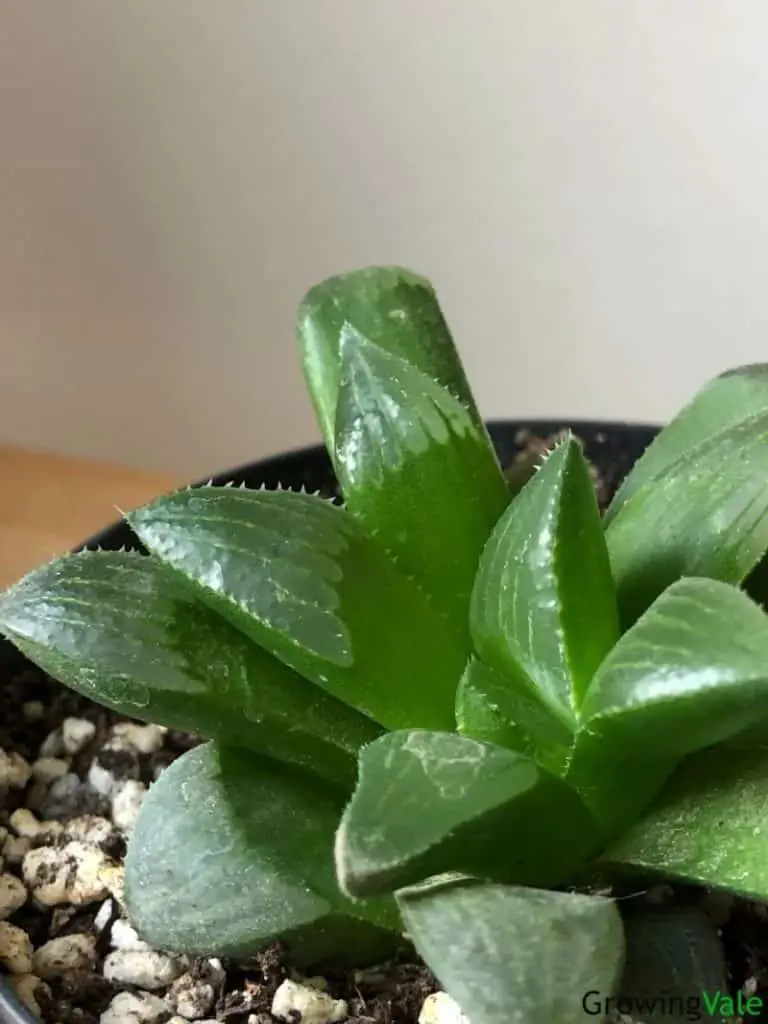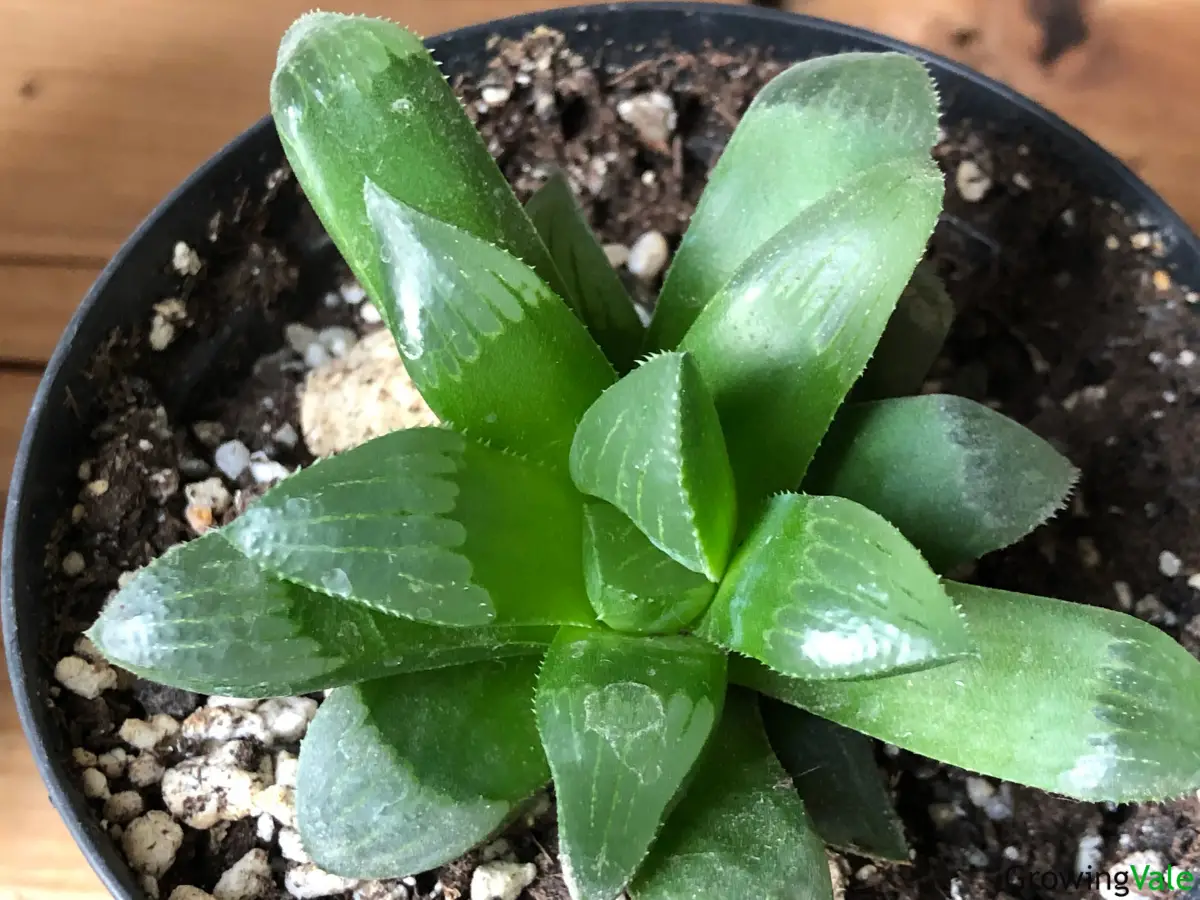Haworthia retusa is a perennial succulent that any collector would love. Its delicate leaves are an absolute joy to look upon due to their translucence. They appear plump with water and just about ready to burst at any given moment! The upper surfaces are faintly lined with green stripes, accentuating the tapered appearance of the leaves.
The species epithet, ‘retusa’, is in reference to the star-shaped orientation of the rosette. Each triangular leaf surface resembles the point of a star. Depending on light conditions, the delicate leaves can be bright to dark green in color. They are quite smooth, making the plant have a luster under bright light.
History
Haworthia retusa is endemic to just one small region in South Africa – Riversdale in the Western Cape Province. It is now widely cultivated due to its ornamental appeal. Unsurprisingly, it is a recipient of the RHS Award of Garden Merit, an award given to plants with a remarkable growth performance in the UK.
In the wild, H. retusa rosettes prefer the lower sections of hills and relatively flat terrain. It is often confused with Haworthia turgida due to their similarity in features. Fortunately, they don’t have the same distribution as the latter prefers to grow in mountainous areas.
Plant Facts
| Scientific name | Haworthia retusa |
| Common names | Star Cactus, Aloe retusa, Window Succulent |
| Genus | Haworthia |
| Family | Asphodelaceae |
| Height | 3 inches |
| Width | 6 inches |
| USDA Plant Hardiness Zone | 9a |
| Origin | Western Cape Province, South Africa |
| Flower colors | White |
| Blooming season | Summer |
| Plant/Flower special features | Translucent foliage |
How to Plant and Grow Haworthia retusa
Like other Haworthia species, H. retusa thrives best in porous pots with a well-draining substrate. It can also be planted in outdoor rock gardens, as long as the climate conditions are suitable. Its main growth period is summer.
Planting H. retusa by seed can be challenging for beginner gardeners. Chances of successful propagation are higher when offsets are used. If propagating this species indoors, make sure your setup is exposed to bright light and warm ambient temperatures.

How to Propagate Haworthia retusa
It can take a few years for a Haworthia succulent mother plant to produce offsets, so you may want to consider leaf propagation. To remove intact leaves, it would be best to uproot the entire plant first. Gently excise them from the mother plant with a sterilized knife or blade. You can remove them by hand as well, but note that this can cause leaf breaks that are further away from the base.
Allow all removed leaves to callous over completely before placing them on a thin layer of soil. After a few weeks, the leaves should produce new roots and shoot tissues. When these are large enough, they can be potted in small containers.
Care and Maintenance
Soil
Store-bought cacti and succulent mix would work perfectly for this plant, but you can make your own mix too! A mixture with sand as a base, with added perlite or pumice, should provide ample porousness.
Water
Provide water only when the top few inches of soil have dried out completely. Try to maintain a morning watering schedule as this will allow most of the moisture to evaporate before nightfall.
Fertilizer
H. retusa rosettes may benefit from a low-concentration fertilizer each summer. Avoid fertilizing the plant during winter.
Sunlight
Bright, indirect sunlight is best as full sun exposure can cause the leaves to scorch or dry out. Filtered sunlight will benefit H. retusa pots that are situated indoors.
Temperature and Humidity
H. retusa is cold and frost sensitive. If located outside USDA hardiness zones 9-11, you will have to bring your plant indoors for winter. Intense heat can also be detrimental to the plant, so a shade cloth may be required at the peak of summer.
Pruning
Rosettes of H. retusa never have to be pruned.
Repotting and Transplanting
H. retusa roots will benefit from fresh soil every 2-3 years. When repotting actively growing rosettes, you can shift to a slightly larger pot size to give the roots more room.
Pests and Diseases
H. retusa is sensitive to overwatering, which can cause the entire plant to rot.
Uses of Haworthia retusa
A neatly potted H. retusa rosette can be a charming desk companion. It is also used in cacti and succulent container gardens.
Common Varieties
H. retusa has some stunning subspecies and cultivars. Most of these occur naturally and are the result of hybridization with its closest cousins.
- H. retusa f. fouchei
- H. retusa var. quimutica
- H. retusa var. retusa (synonymous with var. geraldii)
Conclusion
Just as its name indicates, this Haworthia can easily be the star of any plant collection. It is small but extremely special due to its attractive form and ease of care.

